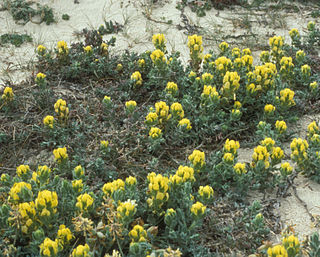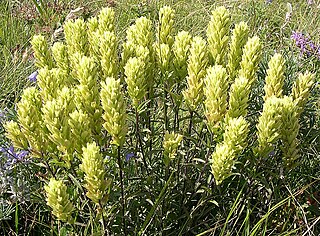
Rubus spectabilis, the salmonberry, is a species of bramble in the rose family Rosaceae, native to the west coast of North America from west-central Alaska to California, inland as far as Idaho. Like many other species in the genus Rubus, the salmonberry plant bears edible fruit, typically yellow-orange or red in color, resembling raspberries in appearance.

Packera obovata, commonly known as roundleaf ragwort, spoon-leaved ragwort, roundleaf groundsel, or squaw-weed, is an erect perennial herb in the Asteraceae (aster) family native to eastern North America. It was previously called Senecio obovatus. Basal and lower leaves are obovate with toothed margins, while upper leaves are pinnately divided. The ray flowers are yellow and the disk flowers orange-yellow, the inflorescences being held well above the foliage.

The Tiburon paintbrush or Tiburon Indian paintbrush is an endangered taxon of flowering plant in the family Orobanchaceae. It is endemic to the San Francisco Bay Area in California in the United States, where it occurs in Marin, Napa, and Santa Clara Counties.

Castilleja exserta is a species of plant in the genus Castilleja which includes the Indian paintbrushes. Its common names include purple owl's clover, escobita, and exserted Indian paintbrush.

Castilleja angustifolia is a species of wildflower known by the common names northwestern Indian paintbrush and desert Indian paintbrush. It is an herbaceous perennial native to the desert, scrublands, and woodlands of western North America. It grows in hot sandy soils and rock crevices in dry conditions.

Castilleja ambigua is a species of Indian paintbrush known by the common name Johnny-nip. It is native to western North America from British Columbia to California, where it is most common along the coast in salt marshes and scrub.

Castilleja affinis is a species of Castilleja known by the common name coast Indian paintbrush.

Castilleja campestris is a species of Indian paintbrush known by the common name vernal pool Indian paintbrush. It is native to California and southern Oregon, where it grows in seasonally moist habitat, especially vernal pools.

Castilleja miniata is a species of Indian paintbrush known by the common name giant red Indian paintbrush. It is native to western North America from Alaska to Ontario to California to New Mexico, where it grows usually in moist places in a wide variety of habitat types.

Castilleja mollis is a species of Indian paintbrush known by the common name softleaf Indian paintbrush. It is endemic to the Channel Islands of California, where it is currently known only from Santa Rosa Island. An occurrence was once noted on San Miguel Island, but the plant has not been found there since 1938. Its habitat is the coastal sage scrub around the windy sand dunes and bluffs.

Castilleja parviflora is a species of Indian paintbrush known by the common name mountain Indian paintbrush. It is native to western North America from Alaska to California, where it grows in high mountain habitat, including areas of alpine climate.

Castilleja subinclusa is a species of Indian paintbrush known by the common names longleaf Indian paintbrush and Franciscan paint brush.

Castilleja pruinosa is a species of Indian paintbrush known by the common name frosted Indian paintbrush. It is native to California and Oregon, where it grows in several types of forested habitat.

Castilleja occidentalis is a member of the genus Castilleja (paintbrush), commonly referred to as western Indian paintbrush. Like other members, it is a hemi-parasite.

Castilleja levisecta is a rare species of flowering plant in the family Orobanchaceae known by the common name golden paintbrush, or golden Indian paintbrush, listed under the Endangered Species Act in 1997. It is native to British Columbia and Washington, where it is known from eleven remaining populations. It occurred in Oregon but all natural occurrences there have been extirpated. It has been reintroduced to a few areas in Oregon, but it remains to be seen if the plants will survive. The plant is a federally listed endangered species of Canada and was listed as threatened in the United States in 1997. On June 30, 2021, the plant was proposed for delisting due to recovery.

Corydalis micrantha is a species of flowering plant in the poppy family (Papaveraceae), native to the United States. Common names include smallflower fumewort, southern corydalis, and golden corydalis.
Castilleja kerryana is a species of flowering plant in the family Orobanchaceae. It is commonly known as Kerry's Indian paintbrush or Kerry’spaintbrush. It was formally described in 2013 and so far it is known only from a small population in the state of Montana, in the Northwestern United States.
Leavenworthia crassa is a species of flowering plant in the mustard family, Brassicaceae, known commonly as the fleshy-fruit gladecress. It is endemic to Alabama in the United States, where it occurs in only two counties. It is "likely one of the most imperiled plant species in the Southeast," and the United States Fish and Wildlife Service issued a final rule listing it as an endangered species in 2014.

Castilleja hispida is a species of flowering plant in the family Orobanchaceae, also known by the common name harsh paintbrush, or harsh Indian paintbrush. It is native to British Columbia, Alberta, Washington, Idaho, Montana, and Oregon.

Castilleja kraliana, is a species of flowering plant in the family Orobanchaceae known by the common names Cahaba paintbrush or Cahaba Indian paintbrush.




















